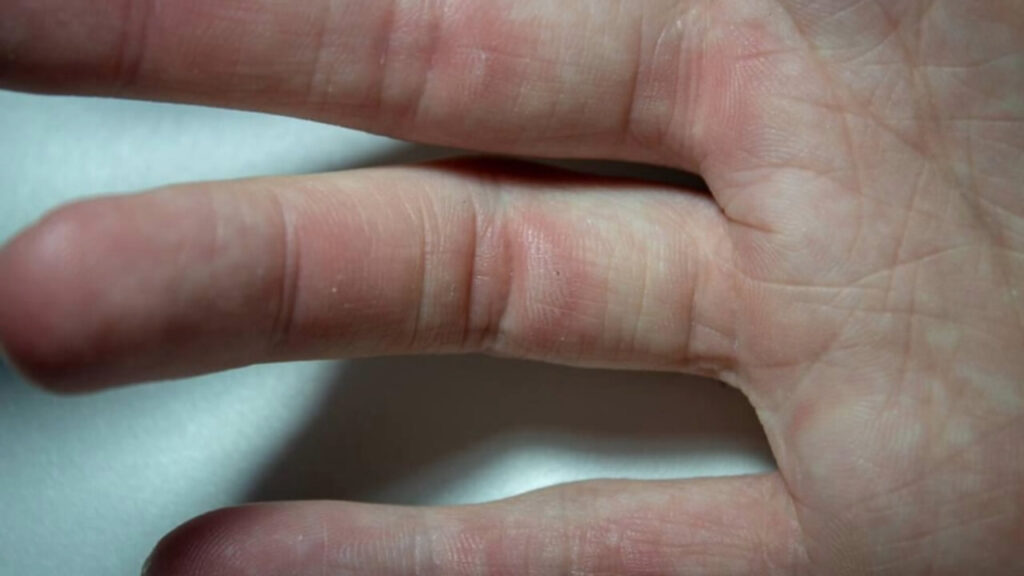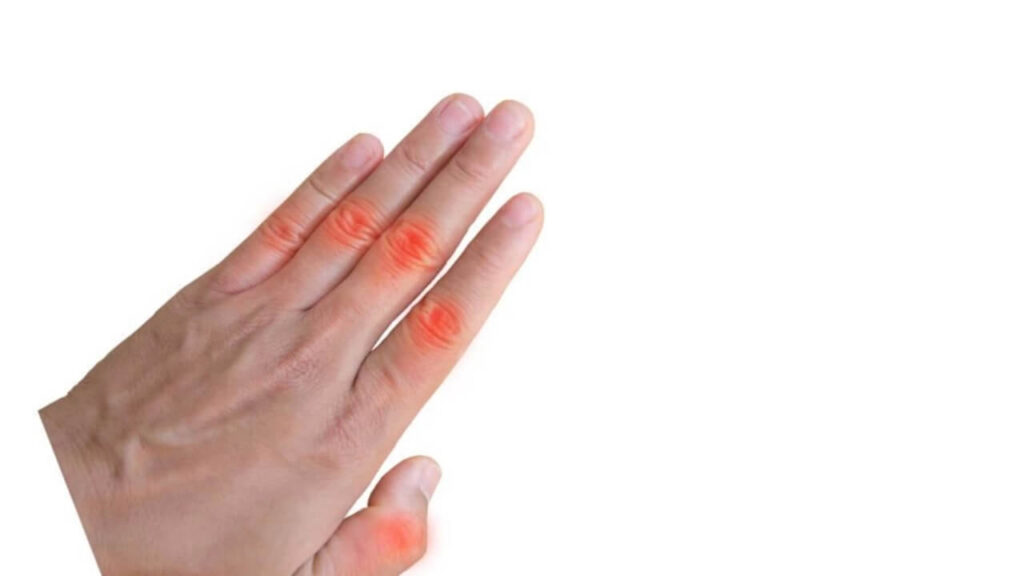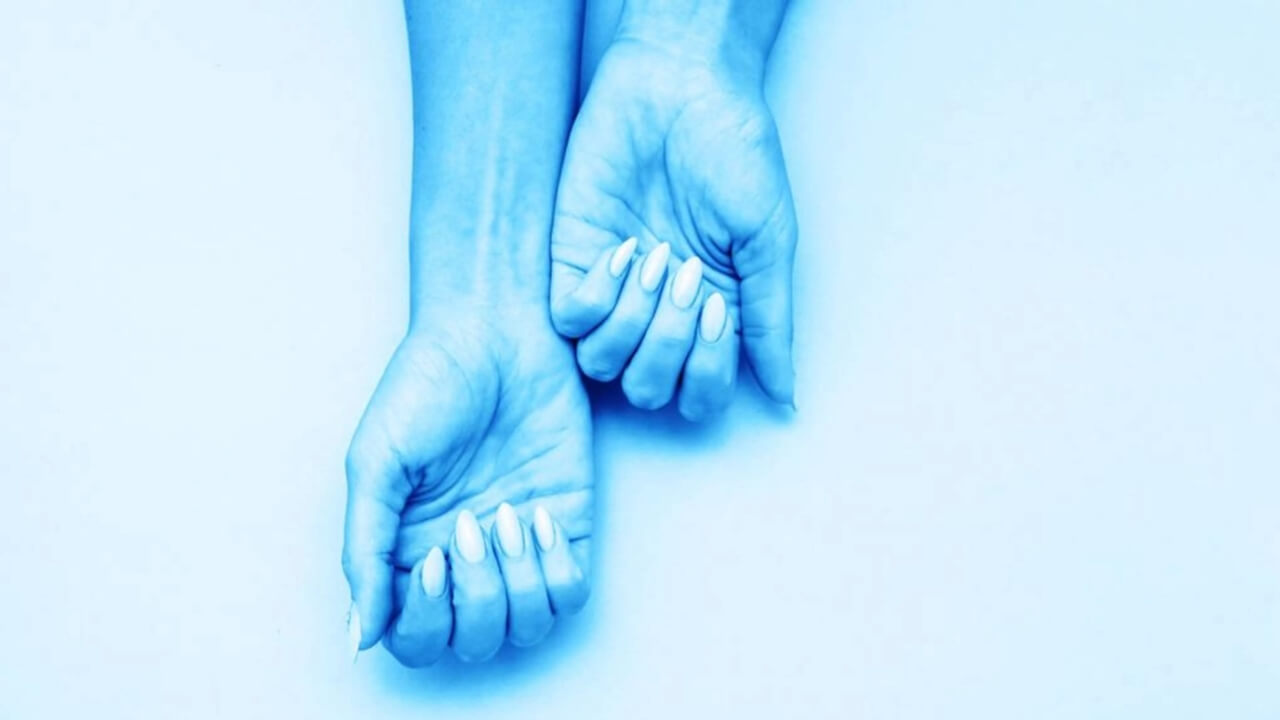If the fingers and toes start turning white and blue during the cold season, then do not make the mistake of ignoring it, because it can be a symptom of a serious disease.

The body overreacts to cold, causing the blood vessels in the arms and legs to constrict so much that they turn fatally white, yellow, and eventually blue.
This color change occurs because there is a lack of oxygen in the blood. This is called ‘Raynaud’s disease’, in which the skin may also feel cold or numb.
As the blood vessels relax and reopen, the skin may look red or feel tingling.

Understanding Raynaud’s Disease
Raynaud’s disease, also known as Raynaud’s phenomenon, is a condition where certain areas of the body, such as the fingers and toes, become numb and cold in response to cold temperatures or stress. Let’s explore this further:
Symptoms:
- Cold Fingers or Toes: During an episode of Raynaud’s, affected fingers or toes feel extremely cold.
- Skin Discoloration: The skin in these areas may turn white, yellow, and eventually blue due to constricted blood vessels.
- Numbness and Pain: You might experience a prickly or stinging sensation when warming up or relieving stress.
- Redness Upon Warming: As the blood vessels relax and reopen, the skin may appear red and feel tingling.
Causes:
Raynaud’s occurs when arteries narrow excessively, limiting blood supply to specific body parts (such as fingers, toes, ears, or nose).
The exact reasons are not fully understood, but both primary and secondary forms exist:
- Primary Raynaud’s: Often triggered by cold weather or stress.
- Secondary Raynaud’s: Associated with underlying conditions like lupus, scleroderma, rheumatoid arthritis, or atherosclerosis.
Remember, if you experience symptoms suggestive of Raynaud’s, seek medical advice to manage and understand this condition effectively. 🌬️❄️
Reason
Sometimes there is no reason for this type of disease, but diabetes, spondylitis or many other diseases can also be the reason for such symptoms in the body.
Raynaud’s disease, also known as Raynaud’s phenomenon, is a condition where certain areas of the body, such as the fingers and toes, become numb and cold in response to cold temperatures or stress. While the exact cause remains unclear, several factors may contribute to its development:
Primary Raynaud’s:
- In most cases, the cause is unknown (idiopathic).
- It often occurs due to an overreaction of blood vessels to cold or stress.
- Genetic factors and abnormal nerve control of blood flow play a role.
Secondary Raynaud’s:
It can be a symptom of underlying diseases, including:
- Autoimmune Disorders: Conditions like lupus, scleroderma, and rheumatoid arthritis.
- Blood Disorders: Increased blood thickness due to excess platelets or red blood cells.
- Hormonal Imbalances: Thyroid disorders or adrenal gland dysfunction.
- Medications: Some drugs can trigger Raynaud’s.
- Injuries: Trauma or repetitive stress.
- Smoking: Nicotine constricts blood vessels.
- Occupational Exposure: Vibrating tools or chemicals.
- Other Factors: Diabetes, spondylitis, and more.
Symptoms:
- Cold fingers or toes.
- Numbness.
- Skin discoloration (white or blue) upon exposure to cold or stress.
- Redness and throbbing pain upon warming up.
Do Not Ignore
In the initial stages of this disease, itching, pain, redness of fingers, swelling and numbness are seen in the fingers. After that, when blood circulation decreases further, it becomes white or blue.
Due to cold, there is a narrowing of the blood vessels that supply blood to the skin, causing pain at the ends of the fingers or nose and ears, which feels strange. In this disease the skin turns white, red and eventually blue in extreme cases.

Raynaud’s disease is a condition that affects blood flow to certain areas of the body, particularly the fingers and toes. Let’s delve into the details:
Early Symptoms:
- Itching: Some individuals experience itching in the affected fingers.
- Pain: Pain, redness, and swelling may occur.
- Numbness: Fingers become numb due to reduced blood flow.
Progression:
- As the disease progresses, blood circulation decreases further.
- The affected areas turn white or blue due to inadequate blood supply.
- Cold temperatures exacerbate symptoms.
Pain and Discoloration:
Blood vessels supplying the skin narrow, causing pain at the fingertips, nose, and ears.
Skin color changes:
- White: Lack of blood flow.
- Red: Blood flow returns, causing throbbing pain.
- Blue: Severe cases with prolonged blood vessel constriction.
Remember, if you experience these symptoms, consult a healthcare professional for proper evaluation and management. 😊
Treatment is Possible
Blue and white fingers are considered a disease of the tissues (Connective Tissue Disorder) in the medical world, but its risk increases in patients with diabetes and high blood pressure. This disease is seen more in women. This disease can damage your fingers and in the last stages of the disease, the fingers may have to be amputated when the blood circulation in the fingers completely stops.
Treatment and Management:
Self-Care Measures:
- Keep warm by wearing gloves, socks, and warm clothing.
- Avoid exposure to cold.
- Stop smoking.
- Protect hands from trauma or vibrations (e.g., using vibrating tools).
Medications:
- Calcium channel blockers (e.g., nifedipine, amlodipine) widen blood vessels and reduce the severity of attacks.
- Alpha blockers (e.g., prazosin, doxazosin) balance norepinephrine activity.
- Vasodilators (e.g., nitroglycerin) relax blood vessels.
- Onabotulinum toxin A injections can block sympathetic nerves.
Surgery:
- Rarely, nerve surgery may be considered to reduce unintended responses.
Diet:
- Consume foods rich in vitamin B, omega-3 fatty acids, calcium, magnesium, and vitamin E.
Consult Specialists:
- Rheumatologists and dermatologists can provide specialized care.
Remember to consult a healthcare provider for personalized advice and management. If you experience severe symptoms, seek medical attention promptly. Raynaud’s phenomenon can be managed effectively with proper care and lifestyle adjustments. 😊
Prevention is Important
This disease can cause problems in winter, hence in such weather avoid cold, wear warm clothes and gloves. Keep ears and nose covered. Avoid putting your hands in cold water. Apart from this, you should also neither smoke nor consume caffeine. Any kind of physical activity and exercise can help you get rid of this. This disease can increase due to increase in blood pressure, diabetes and stress.
Let’s explore some natural ways to improve circulation and lifestyle changes that can help manage Raynaud’s symptoms. Additionally, I’ll address the link between caffeine and Raynaud’s disease:
Improving Circulation Naturally:
1. Regular Exercise:
Physical activity improves blood flow. Aim for at least 150 minutes of moderate exercise per week.
2. Balanced Diet:
Include foods rich in antioxidants, vitamins, and minerals. Some beneficial options include:
- Cayenne Pepper: Contains capsaicin, which promotes blood flow by lowering blood pressure and stimulating vasodilators.
- Pomegranate: High in polyphenol antioxidants and nitrates, which improve blood flow.
- Onions: Flavonoid antioxidants widen arteries and veins, enhancing blood flow.
- Cinnamon: May help reduce blood pressure.
- Garlic: Supports heart health and blood vessel function.
- Fatty Fish: Rich in omega-3 fatty acids, which improve circulation.
- Beets: Contain nitrates that enhance blood flow.
- Turmeric: Has anti-inflammatory properties.
- Leafy Greens, Citrus Fruits, Tomatoes, and Berries: All contribute to better circulation.
3. Stay Hydrated:
Proper hydration supports overall well-being.
4. Stress Management:
Chronic stress can worsen Raynaud’s symptoms. Consider meditation, yoga, or relaxation techniques.
Lifestyle Changes for Managing Raynaud’s Symptoms:

- Keep Warm: Wear warm clothing, especially on your hands and feet, during cold weather.
- Avoid Sudden Temperature Changes: Extreme temperature shifts can trigger attacks.
- Quit Smoking: Nicotine constricts blood vessels and worsens symptoms.
- Limit Caffeine: Caffeine can also cause blood vessels to narrow and trigger flare-ups.
- Exercise Regularly: Improves circulation and overall health.
- Breathing Exercises or Yoga: Helps manage emotional stress.
Caffeine and Raynaud’s Disease:

Caffeine-containing products, such as coffee, certain soft drinks, and chocolate, can affect blood vessel constriction and should be avoided.
Remember to consult with a healthcare professional for personalized advice and management strategies. 🌬️❄️
Foods to Avoid for Managing Raynaud’s Symptoms:
While there isn’t a specific “Raynaud’s diet,” certain dietary choices can help alleviate painful flare-ups:
- Caffeine: Avoid it, as it can constrict blood vessels and worsen symptoms.
- Processed Foods: High sodium and unhealthy fats can negatively impact circulation.
- Alcohol: Excessive alcohol consumption can affect blood flow.
- Red Meat: Opt for lean meats and limit red meat intake due to cardiovascular risks.
- Hydrogenated Oils: Avoid these unhealthy fats found in fried foods and processed snacks.
There are Other Reasons
There can be other reasons for numbness of the fingers, like prolapse, carpal tunnel syndrome, or neuropathy. If you do not get any relief from irrigation, consult a doctor. Also, depending on the symptoms, you can also get tests done, like a blood test, a color Doppler, an NCV, or an MRI.
Let’s explore the other potential reasons for numbness in fingers:
Carpal Tunnel Syndrome (CTS):
- CTS is a common condition caused by compression of the median nerve as it passes through the wrist.
- Symptoms include numbness, tingling, and weakness in the thumb, index, middle, and part of the ring finger.
- Risk factors: repetitive hand movements, pregnancy, obesity, and certain medical conditions.
- Diagnosis: Clinical examination, nerve conduction studies, and electromyography (EMG).
- Treatment: Rest, wrist splints, pain management, and sometimes surgery.
Neuropathy:
- Neuropathy refers to damage or dysfunction of peripheral nerves.
- It can cause numbness, tingling, and pain in various body parts, including the fingers.
- Causes: Diabetes, alcohol abuse, infections, autoimmune diseases, and certain medications.
- Diagnosis: Nerve conduction studies, blood tests, and sometimes skin biopsies.
- Treatment: Address underlying causes, pain management, and lifestyle modifications.
Prolapse (prolapsed intervertebral disc):
- Prolapsed discs occur when the soft cushion-like discs between spinal vertebrae bulge or rupture.
- If a disc in the neck (cervical spine) compresses nerves, it can lead to numbness or weakness in the arms and fingers.
- Diagnosis: MRI or CT scans.
- Treatment: Rest, physical therapy, pain relief, and in severe cases, surgery.
Diagnostic Tests:
- Blood Tests: To check for underlying conditions (e.g., diabetes, vitamin deficiencies).
- Color Doppler: Evaluates blood flow in arteries and veins.
- Nerve Conduction Velocity (NCV): Assesses nerve function.
- MRI (Magnetic Resonance Imaging): Provides detailed images of soft tissues and nerves.
Remember, if you experience persistent numbness or worsening symptoms, consult a healthcare professional for accurate diagnosis and personalized advice.
Wear Socks and Gloves
Actually, it is a common thing for hands and feet to become numb in cold. This is called 'Raynaud's disease'. But it can be fatal for the organs of people suffering from diabetes, hypertension and heart disease. If a little caution is taken in this situation, it can be avoided. Using proper clothing, socks, and gloves and consulting your doctor can prevent your fingers from getting damaged. Diabetic patients have more problems with their fingers. If such patients do not get any relief even after warming the fire, massaging, staying away from cold, then consult your doctor. In this disease, any kind of carelessness can damage your fingers. Avoid cold, wear warm clothes and gloves. Keep ears and nose covered. Avoid putting your hands in cold water.


































Geat post.
Real good info can be found on blog. “Even if happiness forgets you a little bit, never completely forget about it.” by Donald Robert Perry Marquis.
Generally I do not read article on blogs, but I would like to say that this write-up very forced me to try and do so! Your writing style has been amazed me. Thanks, quite nice post.
Hello too every body, it’s myy firsdt pay a quick visit of thiks website; this weblog contains awsesome annd really good information ffor readers.
Hello there, jusst became alett tto your blog through Google,and found tha
it’s truly informative. I’m gonnha watfch out for brussels.
I’ll appreciate if you continhue this in future. A lot off people will be enefited frokm your writing.
Cheers!
I haven?¦t checked in here for a while because I thought it was getting boring, but the last few posts are good quality so I guess I?¦ll add you back to my daily bloglist. You deserve it my friend 🙂
I think this internet site holds some real great information for everyone. “The best friend is the man who in wishing me well wishes it for my sake.” by Aristotle.
Some truly nice stuff on this website , I enjoy it.